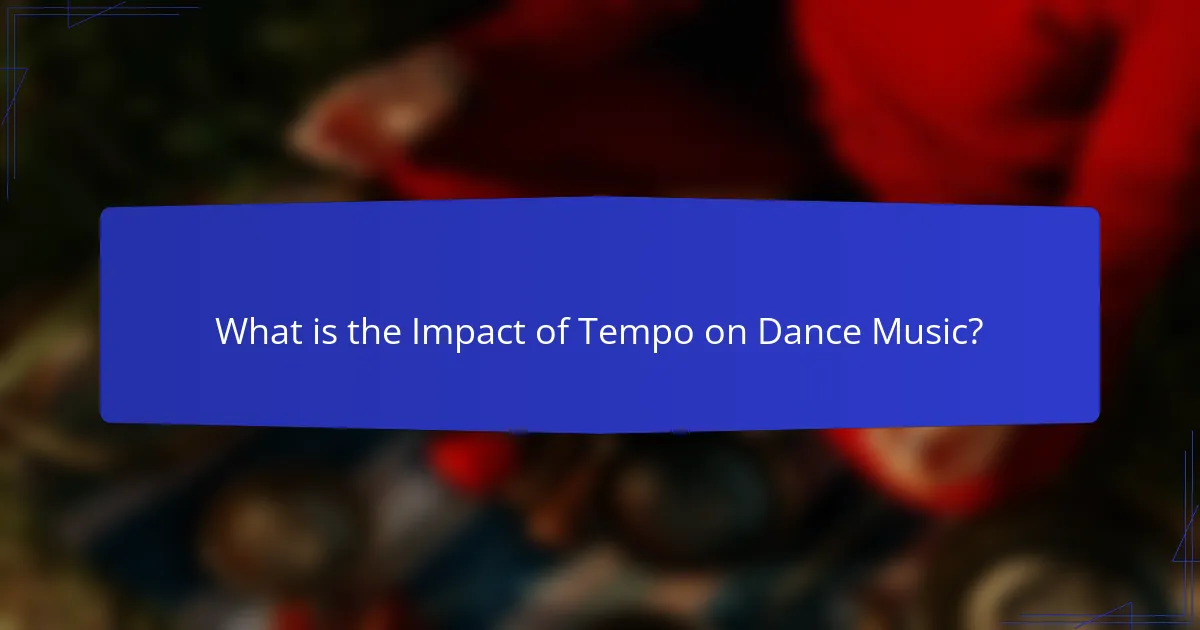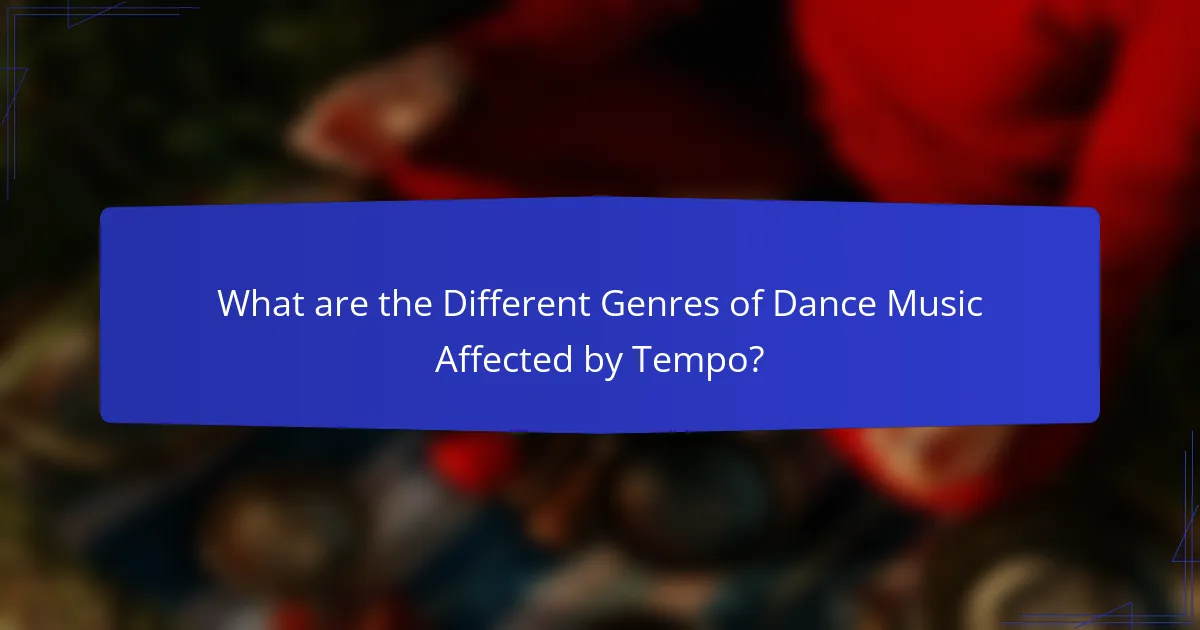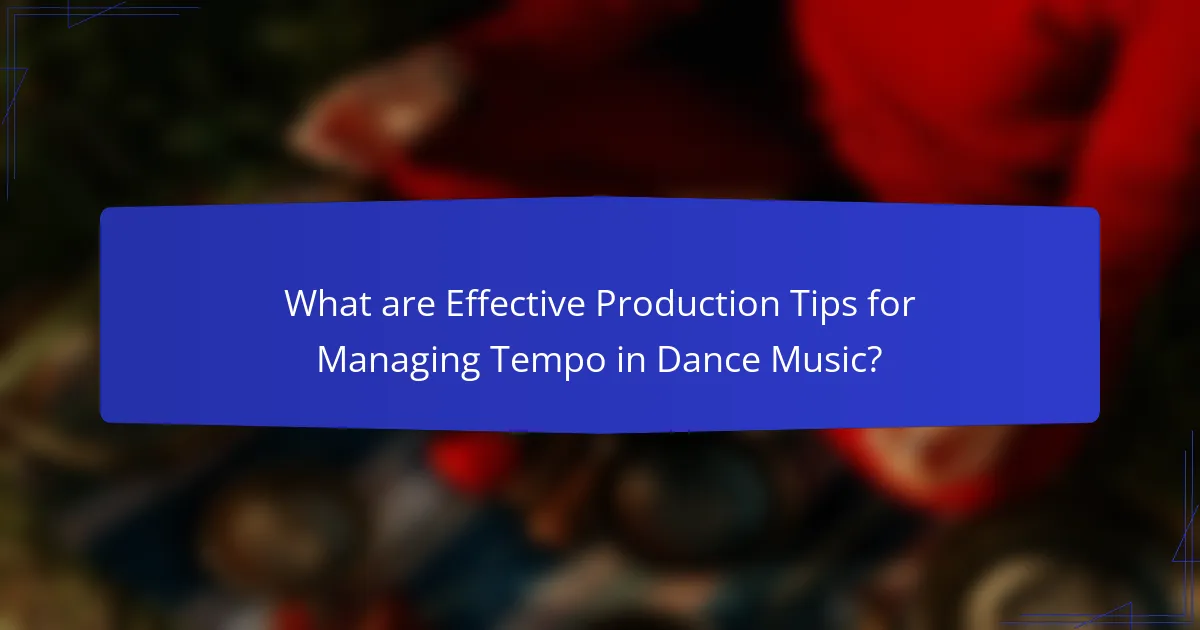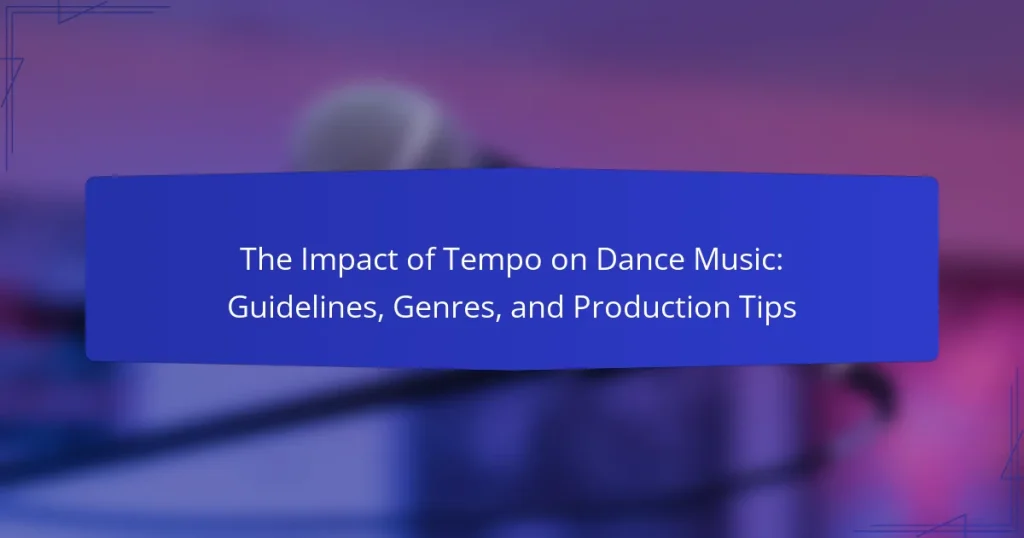Tempo is a critical element in dance music, significantly influencing its energy and overall feel. This article explores how different tempos, typically ranging from 60 to 180 BPM, affect various genres such as house, techno, drum and bass, and trance. It highlights the relationship between tempo and listener engagement, detailing how faster tempos create an energetic atmosphere while slower tempos evoke relaxation. Additionally, the article provides practical production tips for managing tempo effectively, emphasizing the importance of establishing a clear BPM and utilizing techniques like metronomes and tempo automation to enhance the dance music experience.

What is the Impact of Tempo on Dance Music?
Tempo significantly influences dance music by determining its energy and overall feel. Faster tempos, typically ranging from 120 to 150 BPM, create an upbeat and energetic atmosphere. This encourages movement and engagement on the dance floor. Conversely, slower tempos, around 60 to 100 BPM, tend to evoke a more relaxed or emotional response. Different genres utilize tempo variably; for instance, house music often features tempos around 125 BPM, while drum and bass can exceed 160 BPM. Studies show that tempo can affect listeners’ heart rates and physical responses, further enhancing the dance experience.
How does tempo influence the overall feel of dance music?
Tempo significantly influences the overall feel of dance music. It determines the energy level and emotional response of the track. Faster tempos, typically ranging from 120 to 150 BPM, create a sense of excitement and urgency. This is common in genres like techno and house music. Slower tempos, usually below 120 BPM, evoke a more relaxed and laid-back vibe. This is often found in genres like downtempo and chillout music. The choice of tempo can also affect the danceability of a track. Research shows that listeners often perceive faster tempos as more suitable for dancing. Therefore, tempo plays a crucial role in shaping the listener’s experience and engagement with dance music.
What are the different tempo ranges commonly used in dance music?
Common tempo ranges in dance music typically fall between 120 and 130 BPM. Genres like house music often use tempos around 120 BPM. Techno tends to range from 125 to 135 BPM. Drum and bass usually has a faster tempo, ranging from 160 to 180 BPM. Dubstep often sits between 140 and 150 BPM. These ranges are widely recognized within the music industry. They influence the energy and style of the dance tracks produced.
How does tempo affect the emotional response of listeners?
Tempo significantly influences the emotional response of listeners. Faster tempos often evoke feelings of excitement and joy. For example, dance tracks with a tempo around 120-130 BPM can create an uplifting atmosphere. Conversely, slower tempos typically induce feelings of sadness or reflection. Tracks with a tempo below 80 BPM can evoke a sense of calm or melancholy. Research by Thaut et al. (1999) indicates that tempo directly correlates with mood changes in listeners. A study published in the Journal of Experimental Psychology found that participants responded more positively to upbeat tempos compared to slower ones. Thus, tempo plays a crucial role in shaping emotional experiences in music.
Why is understanding tempo important for dance music producers?
Understanding tempo is crucial for dance music producers because it dictates the energy and feel of a track. Tempo influences how listeners perceive rhythm and movement. An appropriate tempo can enhance danceability, making a track more engaging. For instance, tempos between 120-130 BPM are common in house music, promoting a steady groove. In contrast, faster tempos may be suitable for genres like drum and bass, typically around 160-180 BPM. Producers must also consider how tempo affects mixing and transitions between tracks. A well-chosen tempo can facilitate smoother DJ sets and audience enjoyment. Thus, mastering tempo is essential for creating effective and captivating dance music.
How does tempo relate to the structure of dance tracks?
Tempo directly influences the structure of dance tracks by determining the speed and energy of the music. It sets the beats per minute (BPM), which dictates how fast or slow the track feels. Common BPM ranges for dance music typically fall between 120 to 130 BPM. This range enhances the track’s ability to engage listeners on the dance floor.
Tempo affects the arrangement of sections in a dance track. For instance, faster tempos often lead to more energetic builds and drops. Conversely, slower tempos may allow for more extended breakdowns and melodic development.
Additionally, tempo can influence the choice of instruments and sounds used in the track. Higher tempos tend to favor percussive elements, while lower tempos might emphasize melodic and harmonic content.
In summary, tempo is a foundational element that shapes the overall structure and feel of dance tracks.
What role does tempo play in the mixing and mastering process?
Tempo significantly influences the mixing and mastering process. It determines the pace and energy of a track. A faster tempo typically results in a more energetic sound. Conversely, a slower tempo can create a more relaxed atmosphere. Mixing decisions, such as EQ and reverb, often depend on the tempo. For example, faster tempos may require tighter bass to avoid muddiness. Mastering also adjusts dynamics based on tempo. Higher tempos often need more compression to maintain clarity. Thus, understanding tempo is crucial for achieving the desired sound in dance music production.

What are the Different Genres of Dance Music Affected by Tempo?
House, techno, drum and bass, and trance are genres of dance music significantly affected by tempo. House music typically ranges from 120 to 130 BPM. Techno often falls between 120 and 150 BPM. Drum and bass is faster, usually between 160 and 180 BPM. Trance generally has a tempo range of 125 to 150 BPM. Each genre’s tempo influences its energy and danceability. For instance, faster tempos in drum and bass create an intense atmosphere. Conversely, house music’s moderate tempo fosters a more relaxed vibe. This relationship between tempo and genre is crucial for producers and DJs in crafting sets.
How do various dance music genres utilize tempo differently?
Different dance music genres utilize tempo in distinct ways to create specific feelings and energy levels. For instance, house music typically features a tempo range of 120 to 130 BPM, promoting a steady groove ideal for dancing. In contrast, drum and bass operates at a much faster pace, often between 160 to 180 BPM, which generates an intense, high-energy atmosphere.
Techno generally maintains a tempo of 125 to 135 BPM, facilitating a hypnotic and repetitive experience. Meanwhile, trance music usually ranges from 125 to 150 BPM, focusing on uplifting melodies and emotional build-ups.
Dubstep, on the other hand, is characterized by a tempo of around 140 BPM but incorporates half-time rhythms, creating a heavy and impactful sound. Each genre’s unique tempo contributes to its overall vibe and listener engagement.
What are the typical BPM ranges for popular dance music genres?
The typical BPM ranges for popular dance music genres vary significantly. House music usually falls within 120 to 130 BPM. Techno tends to range from 120 to 150 BPM. Trance often features BPMs between 125 and 150. Dubstep typically has a slower tempo, ranging from 140 to 150 BPM. Drum and Bass usually operates at a higher tempo, around 160 to 180 BPM. Each genre’s BPM influences its energy and danceability. These ranges are widely recognized in music production and DJing communities.
How does tempo variation create distinct sub-genres within dance music?
Tempo variation creates distinct sub-genres within dance music by defining the speed and energy of tracks. Different tempos evoke varying emotional responses and facilitate unique rhythmic patterns. For instance, house music typically ranges from 120 to 130 BPM, promoting a steady groove. In contrast, drum and bass operates between 160 to 180 BPM, creating an intense, fast-paced environment. These differing tempos influence the overall feel and structure of the music. Genres like trance, which often hover around 130 to 140 BPM, emphasize melodic builds and euphoric drops. Conversely, techno, usually at 125 to 135 BPM, focuses on repetitive beats and minimalistic elements. The specific tempo not only shapes the genre’s identity but also attracts different audiences and dance styles. Thus, tempo serves as a fundamental characteristic that delineates one dance music sub-genre from another.
What are some examples of how tempo shapes specific dance genres?
Tempo significantly influences various dance genres. For example, in ballet, a slower tempo allows for graceful movements and intricate poses. Conversely, a faster tempo in hip-hop encourages dynamic, energetic choreography. In salsa, the moderate tempo facilitates quick footwork and intricate partner interactions. The upbeat tempo of electronic dance music (EDM) drives high-energy movements and crowd engagement. In contrast, a slower tempo in contemporary dance promotes emotional expression and fluidity. Each genre’s unique tempo shapes its characteristic movements and overall feel, demonstrating the critical role of tempo in dance.
How does tempo influence the characteristics of House music?
Tempo significantly influences the characteristics of House music. House music typically ranges from 120 to 130 beats per minute (BPM). This tempo creates a steady, danceable rhythm essential for club settings. A faster tempo can energize tracks, making them suitable for peak dancefloor moments. Conversely, a slower tempo allows for more groove and swing, enhancing melodic and harmonic elements. The choice of tempo also affects the arrangement and layering of sounds. For example, a higher tempo may lead to more percussive elements, while a lower tempo can emphasize basslines and vocals. Overall, tempo shapes the emotional and physical response of listeners, guiding their movements on the dancefloor.
What is the significance of tempo in EDM and Trance music?
Tempo is crucial in EDM and Trance music as it dictates the energy and pace of the track. Typically, EDM ranges from 120 to 150 BPM, while Trance often falls between 125 to 145 BPM. This tempo range influences the listener’s emotional response and dancing rhythm. Faster tempos create high energy, encouraging vigorous movement. Slower tempos can evoke a more relaxed, introspective mood. The choice of tempo also affects the arrangement and structure of the music. For instance, build-ups and drops are timed to enhance the impact of the track. Additionally, tempo influences the mixing and transitioning between songs during live performances. Overall, tempo serves as a foundational element that shapes the overall experience of EDM and Trance music.

What are Effective Production Tips for Managing Tempo in Dance Music?
Effective production tips for managing tempo in dance music include setting a clear BPM at the start. This establishes the desired energy level for the track. Use a metronome to maintain consistent timing during recording. Layer percussive elements to enhance rhythmic stability. Experiment with tempo changes to create dynamic shifts within the track. Utilize tempo automation to adjust sections for build-ups and drops. Analyze tracks from successful dance music producers for inspiration on tempo management. Studies show that tracks around 120-130 BPM are popular in dance music genres, making this range a good target.
How can producers choose the right tempo for their tracks?
Producers can choose the right tempo for their tracks by considering the genre and the intended emotional impact. Each genre has typical tempo ranges; for example, house music often falls between 120-130 BPM, while drum and bass ranges from 160-180 BPM. The emotional response to tempo also varies; faster tempos can create excitement, while slower tempos may evoke calmness. Producers should also experiment with different tempos during the creative process. Listening to how the tempo affects the overall feel of the track is crucial. Additionally, using a metronome can help maintain consistent timing. Ultimately, the right tempo enhances the track’s groove and listener engagement.
What techniques can be used to manipulate tempo creatively?
Techniques to manipulate tempo creatively include tempo changes, polyrhythms, and tempo modulation. Tempo changes involve altering the speed of a track at specific points for dynamic effect. Polyrhythms introduce contrasting rhythms that create a complex texture, enhancing interest. Tempo modulation allows gradual changes in speed, creating a sense of movement. These techniques can evoke different emotions and energy levels in dance music. Historical examples show that artists like Daft Punk and Aphex Twin effectively use these methods to engage listeners.
How does tempo syncing with other elements enhance a track?
Tempo syncing with other elements enhances a track by creating cohesion and rhythm. When the tempo of drums, bass, and synths align, it establishes a unified groove. This synchronization makes the music more engaging for listeners. It encourages movement and dancing, which is essential in dance music. Studies show that tracks with synced tempos are perceived as more enjoyable. The energy level of a track is also amplified through tempo syncing. This can lead to a more immersive experience for the audience. Overall, tempo syncing is crucial for maintaining energy and flow in dance music.
What common challenges do producers face regarding tempo?
Producers commonly face challenges in maintaining consistent tempo throughout a track. Variations in tempo can disrupt the flow of a song. This inconsistency can lead to difficulties in mixing and mastering. Additionally, tempo changes can confuse listeners and dancers alike. Producers also struggle with aligning tempo to genre expectations. Each genre has its typical tempo range, which can limit creativity. Furthermore, syncing tempo with other elements, like vocals or instruments, poses additional hurdles. Lastly, adapting to the tempo preferences of different audiences can complicate production decisions.
How can tempo discrepancies affect the mixing process?
Tempo discrepancies can significantly disrupt the mixing process. When tracks have different tempos, aligning them becomes challenging. This misalignment can lead to a lack of cohesion in the mix. Additionally, it may cause phase issues, resulting in a muddy sound.
Tracks that are not in sync can also create unintended rhythmic clashes. These clashes can detract from the overall musicality of a piece. Furthermore, tempo discrepancies may necessitate time-stretching or pitch-shifting. Such adjustments can introduce artifacts, affecting audio quality.
Overall, maintaining consistent tempo across tracks is crucial for a polished mix.
What are best practices for maintaining consistent tempo throughout a track?
To maintain consistent tempo throughout a track, use a metronome during the recording process. A metronome provides a steady beat, helping musicians stay in sync. Additionally, utilize a digital audio workstation (DAW) with a tempo track feature. This allows for precise tempo adjustments and ensures uniformity across the entire piece. Regularly check the tempo with tempo detection tools in the DAW. This helps identify any fluctuations that may occur during recording or mixing. Lastly, practice regularly with the intended tempo to internalize the rhythm. Studies show that consistent practice leads to improved timing and overall performance quality.
What are practical tips for experimenting with tempo in dance music production?
Experimenting with tempo in dance music production can enhance creativity and sound dynamics. Start by adjusting the BPM (beats per minute) to explore different genres. For instance, house music typically ranges from 120 to 130 BPM, while drum and bass can go from 160 to 180 BPM. Use tempo changes within a track to create tension and release. This technique can make transitions more engaging. Additionally, try layering elements at different tempos to create complex rhythms. Utilize a metronome to maintain timing while experimenting. Record multiple versions of a track with varying tempos to compare the results. This practice helps identify which tempo best conveys your intended emotion.
The primary entity of this article is tempo in dance music, which plays a crucial role in shaping the energy, emotional response, and overall feel of various genres. The article explores how different tempo ranges influence danceability and listener engagement, detailing the specific BPMs associated with genres such as house, techno, drum and bass, and trance. Additionally, it provides production tips for managing tempo effectively, including techniques for maintaining consistent timing and creatively manipulating tempo to enhance musical dynamics. Overall, the content emphasizes the significance of tempo in both the emotional impact of dance music and the technical aspects of music production.


